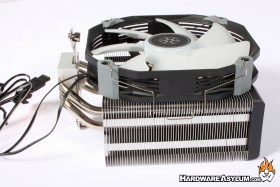SilverStone Argon V140 ARGB CPU Cooler Review
Author: Dennis GarciaIntroduction
Aircooling is one of the oldest and most reliable forms of cooling PC components and the thermal demands of your chip will determine what kind of cooler you need. For instance, most motherboard components only require a small heatsink to remain stable while high-end gaming GPUs often require large heatpipe arrays and multiple fans. Of course, you can push the limits using exotic cooling methods including water and liquid nitrogen but, for the most part aircooling is all you ever really need.
In this review we will be looking at the Argon V140 from SilverStone. We have looked at a number of coolers from SilverStone including three Argon heatsinks and a number of AIO water coolers. The Argon V140 is a single tower cooler comprised of four copper heatpipes and a rather large 140mm finned radiator. Cooling is handled by a single 140mm ARGB fan and looks strikingly like a larger Hyper 212.

As mentioned, the Argon V140 is a single tower cooler featuring a traditional design featuring a bright finish on the cooling fins and nickel coating on the copper heat pipes.
One of the defining features of the Argon coolers is a core contact heatpipe design. This is where the heatpipes are exposed directly to the CPU providing a very fast thermal transfer to even out the thermal spikes from normal computer usage. Overall thermal capacity is reduced however, that is only important under sustained and overclocking loads.
I had mentioned how the Argon V140 looks like the popular Hyper 212 and that is reinforced by the heatpipe position. The four heatpipes exit the cold plate and remain bundled as they enter the radiator. This placement is extremely efficient both from a manufacturing process but also from cooling as the higher velocity air from the fan will make direct contact with the pipes. This enhances thermal transfer and thus cooling performance.
Along the edges you will find a vertical groove for attaching cooling fans. The included ARGB 140mm fan features an RPM range between 400-1750rpm pushing 93CFM with a noise ceiling of 30.8 dBA when running full tilt.

A feature I haven’t seen in a very long time are these vertical slats cut into the fan housing. Ideally, this is done to reduce the overall noise signature while providing new opportunities for RGB lighting to escape.
Heatsink mounting is using a very popular system where you build up a base and attach the heatsink using two captured spring screws. This universal mounting system is very robust allowing for a single heatsink to be installed on multiple systems with very few changes to the mounting hardware.





